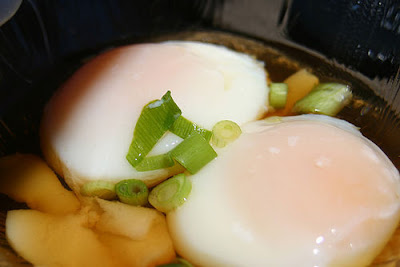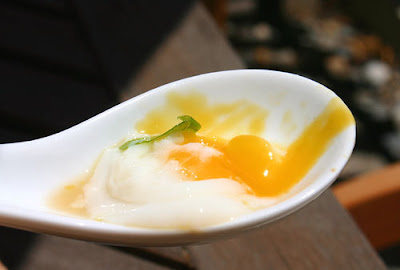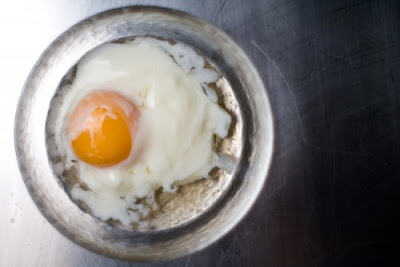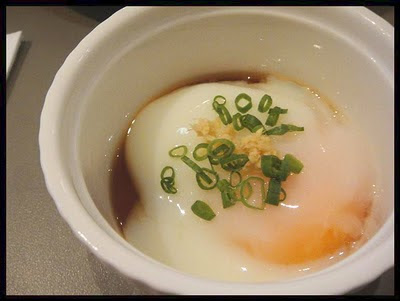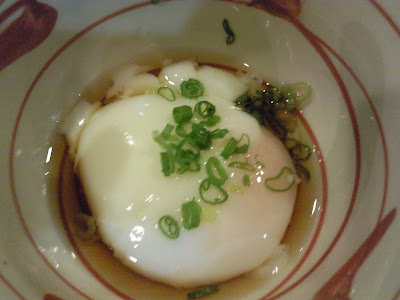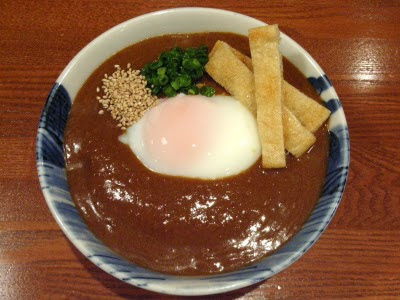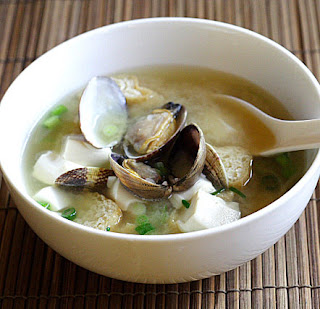For the sauce, I used a recipe from about.com: 1/4 cup dashi and 1 teaspoon soy sauce. Instead of regular soy sauce, I substituted banno-joyu, seasoned soy sauce. I love to have banno-joyu on hand for making a quick sauce for somen noodles, dressing vegetables, making ohitashi, or drizzling over tofu. Plus, it keeps for just about forever in the refrigerator, so I mix up a small batch whenever I run out (It’s also a great way to use up some of the extra shiitake mushroom stems that I have around).

Onsen Tamago (Hot Springs Egg) recipe - Japanese-style breakfast
Slow-Poached Eggs
from Momofuku by David Chang and Peter Meehan
Ingredient:
fresh large eggs
Method:
1. Fill your biggest, deepest pot with water and put it on the stove over the lowest possible heat.
2. Use something to keep the eggs from sitting on the bottom of the pot, where the temperature will be the highest. If you’ve got a cake rack or a steamer rack, use it. If not, improvise; a doughnut of aluminum foil or a few chopsticks scattered helter skelter across the bottom of the pan will usually do the trick, but you know what you’ve got lying around. Be resourceful.
3. Use an instant-read thermometer to monitor the temperature in the pot–if it’s too hot, add cold water or an ice cube. Once the water is between 140°F and 145°F (60-63°C, though I actually let the temperature rise to about 67°C), add the eggs to the pot. Let them bathe for 40 to 45 minutes, checking the temperature regularly with the thermometer or by sticking you finger in the water (It should be the temperature of a very hot bath) and moderating it as needed.
4. You can use the eggs immediately or store them in the refrigerator for up to 24. (If you’re planning on storing them, chill them until cold in an ice-water bath.) If you refrigerate the eggs, warm them under piping-hot tap water for 1 minute before using,
5. To serve the eggs, crack them one at a time into a small saucer. The thin white will not and should not be firm or solid; tip the dish to pour off and discard the loosest part of the white, then slide the egg onto the dish it’s destined for.
To make a sauce, mix 1/4 cup dashi with 1 teaspoon banno-joyu (below). Use 1 to 2 tablespoons of this sauce for each egg.
Banno Joyu: Seasoned Soy Concentrate
from Washoku by Elizabeth Andoh
Ingredients:
5 or 6 large iriko, trimmed (heads and guts removed)
8 to 10 square inches Rausu, Rishiri, or ma kombu
1 dried shiitake mushroom or stems from 3 or 4 mushrooms
1/4 cup atsu kezuri or 1/2 cup tightly packed katsuo-bushi
2/3 cup soy sauce
1/3 cup sake
3 tablespoons sugar
3 tablespoons water
2 tablespoons mirin
Method:
Place the iriko, kombu, mushroom, atsu kezuri, soy sauce, and sake in a small, deep saucepan and leave to infuse for at least 1 hour or up to 12 hours. (If you are using ordinary katsuo-bushi, add the flakes later as directed.)
Add the sugar, water, and mirin to the pan and place over low heat. When the liquid begins to simmer, adjust the heat to keep it from boiling too vigorously. As the sauce simmers, it becomes quite foamy, rising in the saucpan. Watch to make sure it does not overflow. Continue to simmer until the volume has been reduced by about one=fourth and the sauce has become a bit syrupy.
Remove from the heat. (If you are using ordinary katsuo-bushi, scatter the flakes across the surface of the liquid. Let stand for 2 to 3 minutes, until the flakes have settled to the bottom.) Pour through a coffee-filter-lined strainer or a sarashi cloth into a glass jar with a tight-fitting lid. If not using immediately, let cool, cover, and chill before using. Refrigerate for up to 1 month.
credit: http://beyondboulder.wordpress.com/2010/06/03/onsen-tamago/
......................................................................................................................................................







